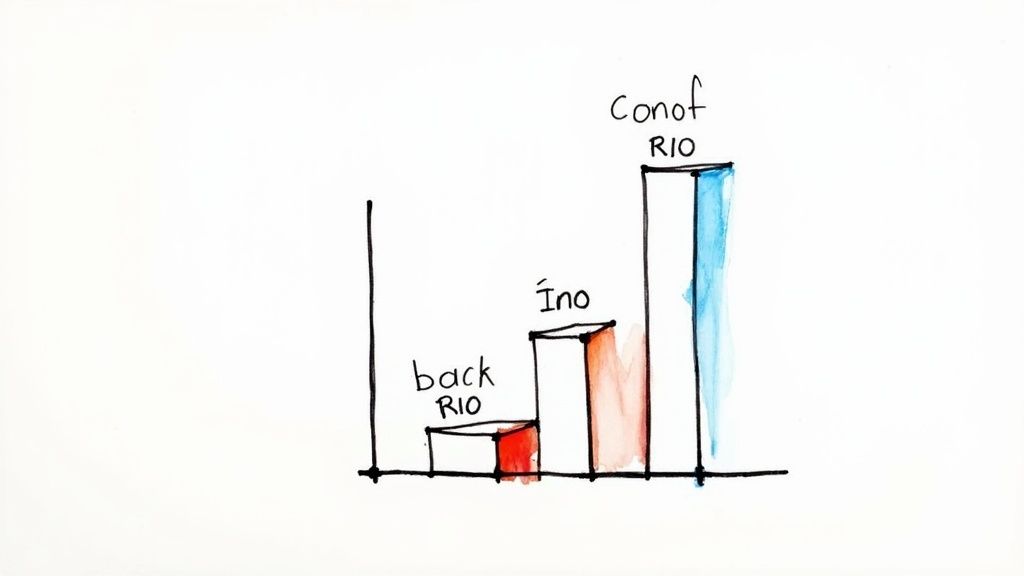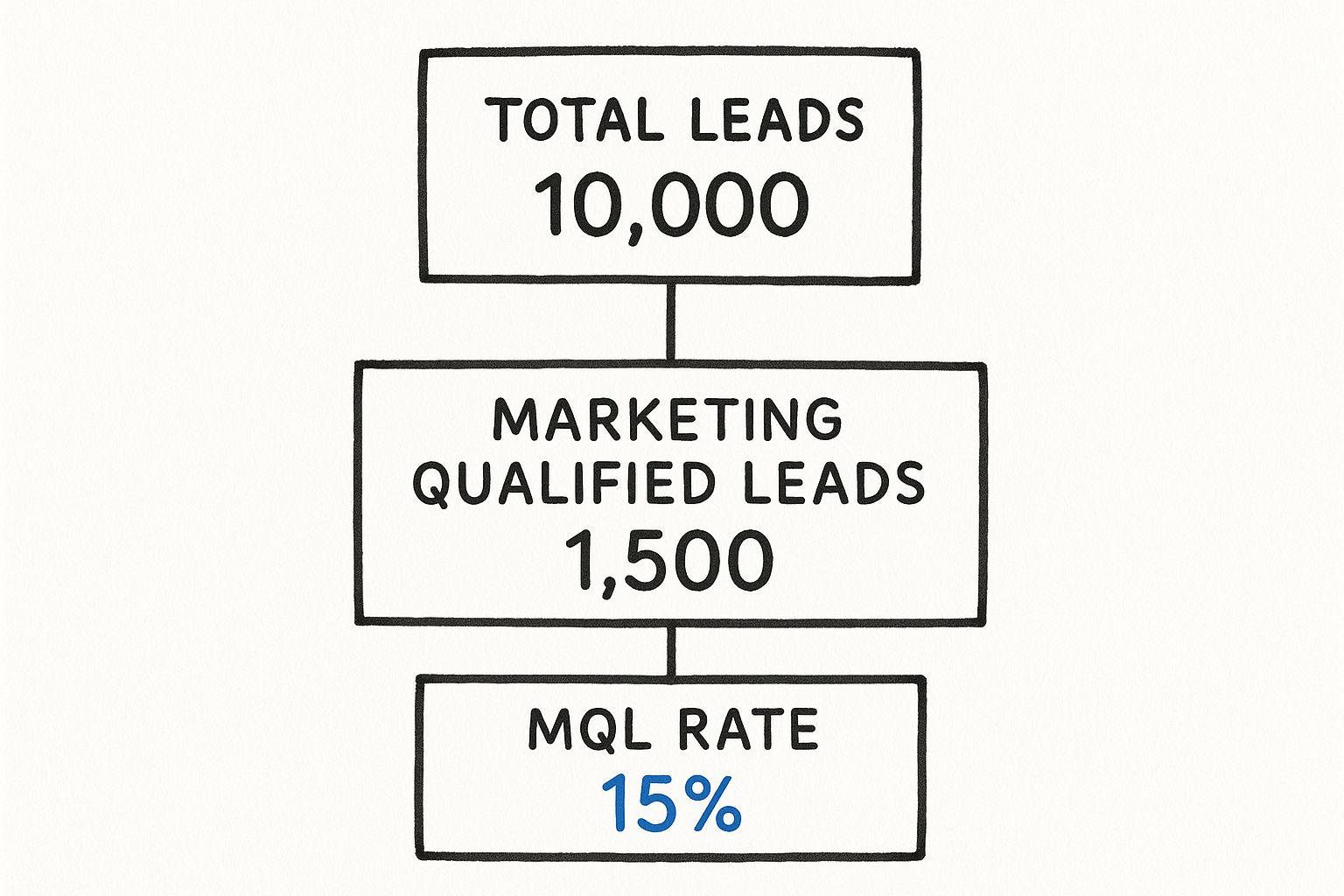Think of the difference between someone just glancing at your ad versus someone who clicks, downloads your pricing guide, and signs up for a demo. That's the core idea behind a Marketing Qualified Lead (MQL) in the Google Ads ecosystem. It’s about separating the casual clickers from the genuinely interested prospects, a crucial first step in making your ad budget work smarter, not harder.
What Is a Marketing Qualified Lead in Google Ads
Let's cut through the jargon. In the world of Google Ads, an MQL isn't just another click or a generic conversion. It's a person who has taken a deliberate step after clicking your ad, signaling they're warming up to the idea of buying.
This "intentional engagement" is what it’s all about. An MQL is someone who has shown they’re more likely to become a customer by taking a specific, meaningful action tracked as a conversion. Maybe they downloaded your latest whitepaper, signed up for a webinar, or spent significant time on your pricing page after arriving from a Search ad. These aren't random clicks; they're valuable signals of real commercial intent.
From a Google Ads Click to a Qualified Prospect
Imagine you're running a Google Ads campaign for a new SaaS product. A person clicks your ad—that's just a raw lead. You don't know much about them or what they really want. Google's algorithm sees a click, but not much else.
But what happens when that same person downloads your "Advanced Guide to Bidding Strategies" or registers for your webinar on "How to Maximize Your ROAS"? That's a different story. They’ve moved past simple curiosity and are now actively researching a solution you provide. This is the moment they transform from a generic lead into a Marketing Qualified Lead. These are the people your marketing efforts should now focus on nurturing toward a sale.
By defining and tracking MQLs in Google Ads, you stop wasting ad spend on low-intent clicks and start training Google's Smart Bidding to find prospects who have essentially raised their hand and said, "I'm interested, tell me more."
Understanding Lead Stages in Your Google Ads Funnel
To really get a handle on this, it helps to see where MQLs fit into the bigger picture of your paid acquisition funnel. A lead doesn't just appear out of nowhere, ready to buy. They go through a few stages, and MQL is the critical bridge between your Google Ads campaigns and your sales team.
Let's break down the typical lead journey originating from Google Ads to see how an MQL stacks up.
Lead Stages At a Glance
| Lead Type | Key Characteristic | Example Google Ads Action |
|---|---|---|
| Lead | Any initial contact from an ad. | Clicks a Google Ad and lands on your site. |
| MQL | Shows marketing-related interest after the click. | Downloads an e-book or signs up for a newsletter from the landing page. |
| SQL | Vetted and ready for a direct sales follow-up. | Fills out a "Request a Demo" or "Contact Sales" form. |
| Opportunity | A qualified prospect with a real sales process underway. | Has a scheduled demo with a sales representative. |
As you can see, an MQL is a lead that your marketing criteria have deemed promising. They've been vetted and are worthy of more attention before being handed off to the sales team to close the deal. In the Google Ads context, this is the conversion action you want to optimize for.
Finding Your MQLs in Google Ads Campaigns

Spotting a real Marketing Qualified Lead (MQL) in a sea of Google Ads clicks is about more than just counting conversions. It’s about tracking the right conversions—the actions that signal genuine buying intent. This is where the true marketing qualified leads definition comes to life for PPC advertisers.
Think about it this way: someone filling out a lead form for a newsletter is one thing. But someone who clicks a "SaaS pricing" ad, lands on your site, and immediately downloads your detailed pricing guide? That’s a completely different level of intent. The first is a lead; the second is a potential MQL.
This is why sharp, specific conversion tracking is so important. Using Google Tag Manager and importing offline conversions, you can set up goals that track only these high-value actions. Your Google Ads reports suddenly shift from celebrating a high volume of low-quality leads to measuring the quality of those leads. If you want to get into the nitty-gritty of setting this up, our complete guide to Google Ads lead generation is a great place to start.
What High-Intent Actions Should You Track as MQLs?
To find your MQLs, you need to define which on-site behaviors, driven by your ads, truly signal a move from browsing to buying.
Here are a few classic examples of high-intent actions to track in Google Ads:
- Content Downloads: When someone gives you their email in exchange for a meaty resource like a case study, whitepaper, or buyer’s guide.
- Webinar Registrations: Signing up for a live event signals a real interest in learning how your solution solves a specific problem.
- Pricing Page Visits: A person spending significant time on your pricing page after an ad click is almost always in evaluation mode.
- Demo Requests: This is the gold standard. Filling out a "Request a Demo" form is one of the strongest buying signals you can get from your campaigns.
By zeroing in on these specific actions as your primary conversion goals, you build a reliable system for identifying MQLs. This doesn't just give you a better sense of how your campaigns are performing—it tells Google's algorithm exactly who to target.
Getting this right is a big deal. The average B2B organization generates around 1,877 leads per month, and with the average cost per lead hovering around $198.44, you can't afford to get it wrong. Properly qualifying leads via MQL criteria is the key to a healthy ROAS. You can find more data on this in these lead generation statistics on ExplodingTopics.com.
Why the MQL Still Matters in the Age of AI-Powered Ads

The concept of a Marketing Qualified Lead was born to solve the classic tension between marketing and sales. Marketing would celebrate bringing in a flood of new leads, only for the sales team to complain that most were low-quality. The MQL was created to be the peacekeeper—a clear, agreed-upon standard for when a lead was actually warm enough to be handed over.
This is especially true in the world of Google Ads, where every single click comes with a price tag. It’s one thing to waste your sales team's time on a dead-end lead; it's another thing entirely to pay Google for the privilege.
The Evolution, Not the Extinction, of MQLs in Google Ads
So, is the MQL dead in the era of Performance Max and automated bidding? Far from it. It's just gotten a lot smarter. The modern MQL isn't based on a single action anymore. Today's definition is data-driven, looking at deeper intent signals that can be fed directly into Google's algorithms.
The MQL isn't an outdated metric; it’s a necessary filter that protects your ad spend and trains Google's AI to find high-potential prospects. It ensures you’re not just generating clicks but cultivating real opportunities.
Understanding why MQLs are crucial today often comes down to how we nurture them. With tools like well-timed automated direct messages or email sequences, we can track meaningful engagement that signals real interest.
By focusing on these high-quality interactions as your primary conversion goal, you're essentially teaching Google’s algorithm to find more people who look just like your best prospects. This refined approach makes the MQL more relevant than ever for getting a solid return on your ad spend.
Drawing the Line Between MQL and SQL in Your Ad Funnel
Knowing the difference between a Marketing Qualified Lead (MQL) and a Sales Qualified Lead (SQL) is absolutely essential for a healthy Google Ads pipeline. This is the official handoff point—where marketing's work to nurture interest ends and sales takes over to close the deal.
Think about it like this: an MQL is someone who clicked your ad for "car safety ratings" and downloaded a comparison guide. They're clearly interested, but they're still in the research phase. The SQL is the person who clicks an ad for "test drive sedan near me" and books an appointment. Their intent has sharpened from general interest to active evaluation.
Getting this distinction right is the bedrock of effective marketing and sales alignment strategies. When the line is blurry, your sales team ends up wasting precious time on leads who are still just kicking the tires, and your ad account data becomes messy.
From Interested Browser to Ready Buyer
So, what’s the tipping point? What actions turn an MQL into an SQL? This jump usually happens when a lead takes a high-intent action that screams, "I'm ready to talk."
The most common triggers include:
- Requesting a personalized demo of your product.
- Asking for a formal price quote or filling out a "Contact Sales" form.
- Directly asking to speak with someone in sales about their specific needs.
To make the distinction crystal clear, here’s a simple breakdown of how these two lead types stack up.
MQL vs SQL Key Differences
| Attribute | Marketing Qualified Lead (MQL) | Sales Qualified Lead (SQL) |
|---|---|---|
| Stage in Funnel | Top/Middle of Funnel (Awareness/Interest) | Bottom of Funnel (Consideration/Decision) |
| Primary Intent | Information gathering and problem-solving | Evaluating solutions and making a purchase decision |
| Typical Actions | Downloads an ebook, subscribes to a newsletter, attends a webinar | Requests a demo, asks for a price quote, starts a free trial |
| Next Step | Continued nurturing with targeted content (emails, case studies) | Direct follow-up from a sales representative |
| Team Responsible | Marketing Team | Sales Team |
This table shows that while MQLs are being nurtured, SQLs are ready for a direct sales conversation. In Google Ads, you might optimize for MQLs at the top of the funnel and SQLs (like "request a demo" form fills) in your bottom-funnel campaigns.
The handoff from MQL to SQL is where the rubber meets the road. A high MQL-to-SQL conversion rate is a great sign that your Google Ads campaigns are hitting the mark.
This diagram shows just how this filtering process works in practice.

As you can see, out of an initial pool of 10,000 leads from various channels, only a focused 15% made the cut to become MQLs. This process ensures the sales team can concentrate its energy on the opportunities most likely to convert.
Fueling Google Ads with Your MQL Data
Having a solid definition for a marketing qualified lead isn't just an internal metric. It’s a powerful tool that can make or break your Google Ads profitability.
Once you know exactly what an MQL looks for your business, you can feed that data directly back into Google Ads. This is how you teach its machine-learning algorithms what a real lead is, not just a cheap form submission.
Think about it: this changes the whole game. Your campaigns stop chasing low-cost clicks and start hunting for high-intent prospects. By setting MQLs as your primary conversion goal, you’re telling Smart Bidding strategies like Target CPA exactly what you value. The algorithm stops optimizing for anyone who fills out a form and starts learning the patterns of users who actually download a pricing guide or book a demo.
Supercharging Your Targeting and Remarketing
When you connect your MQL data to Google Ads, you unlock smarter, more powerful ways to find new customers. Integrating your CRM with Google Ads using Offline Conversion Tracking or Enhanced Conversions for Leads creates a vital data pipeline. It's a feedback loop: the more MQLs you generate and upload, the smarter your campaigns become.
This integration lets you build some seriously effective audience segments.
- Lookalike Audiences: You can upload your MQL list and tell Google, "Go find me more people like these." It’s an incredibly effective way to reach new people who share the same traits as your best leads.
- Hyper-Targeted Remarketing: Got a list of MQLs? Great. Now you can hit them with ads for a free trial or a consultation—offers designed to move them further down the funnel and turn them into SQLs.
- Audience Exclusions: Just as importantly, you can stop showing ads to people who have already converted. Once a lead becomes an MQL (or better yet, an SQL), you can exclude them from your general awareness campaigns. Why waste money on someone already in your sales pipeline?
By using your MQL data this way, you're not just running ads; you're building an intelligent, self-optimizing system. Each MQL you generate teaches Google how to find the next one more cheaply and efficiently, ensuring your ad budget is always working its hardest.
Common Questions About MQLs and Google Ads
Even with a solid plan, a few questions always come up when you start applying the marketing qualified lead definition to your actual Google Ads campaigns. Let's clear up some common sticking points so you can move forward without making expensive mistakes that burn through your ad budget.
Can a Lead Be an MQL and an SQL at the Same Time?
Nope, they can't. Think of it as a one-way street in your funnel. An MQL is a lead that marketing has qualified based on their actions, but sales hasn't officially accepted them yet.
It’s like a baton pass in a relay race. Once the sales team takes the lead, vets them, and confirms they're a genuine opportunity ready for a conversation, that lead "graduates" to become a Sales Qualified Lead (SQL). They can’t be both at once.
Common Mistakes When Defining MQLs for Google Ads
One of the biggest blunders is setting the qualification bar too low. If you call every newsletter signup from a Google Ad an MQL, you’ll swamp your sales team with junk leads and tell the Google algorithm to find more low-intent users.
Another classic mistake is creating MQL criteria without input from sales. This is a recipe for disaster, leading to friction and rejected leads, which confuses your campaign optimization.
Finally, a huge technical error is not setting MQLs as a primary conversion goal in Google Ads. If you don't do this, you're telling Google’s algorithm to chase volume, not value. That's a surefire way to waste your ad spend.
How Do MQLs Help with Performance Max Campaigns?
MQLs are an absolute game-changer for Performance Max (PMax) campaigns. When you import your MQL lists from your CRM and use them as audience signals, you're handing Google's AI a treasure map. You're showing it exactly what a high-quality prospect looks like.
This trains the PMax algorithm to go out and find more people with those same characteristics across all of Google's channels—Search, Display, YouTube, you name it. Your automated campaigns get smarter, more efficient, and laser-focused on bringing in valuable conversions, not just empty clicks.
How Often Should We Update Our MQL Definition?
Your MQL definition should never be a "set it and forget it" document. It’s a living thing that needs regular check-ups, especially in the fast-changing world of Google Ads. At a minimum, review it quarterly with both marketing and sales.
The key metric to watch is your MQL-to-SQL conversion rate. It tells you the whole story.
- Lots of Rejected Leads? If sales is kicking back a high percentage of your MQLs, your criteria are probably too loose, and your Google Ads are attracting the wrong audience.
- Not Enough MQLs? If your pipeline is running dry, your definition might be too strict, filtering out perfectly good leads that your campaigns could be generating.
Use this feedback loop to continuously tweak your definition. This ensures it stays perfectly aligned with your business goals and keeps improving your Google Ads campaign results over time.
Stop letting your hottest leads slip away. With Pushmylead, your Google Ads lead form submissions land directly in your inbox the second they hit submit. Get instant alerts and jump on high-intent leads before your competitors even know they exist. See how to simplify your lead flow at https://www.pushmylead.com.
